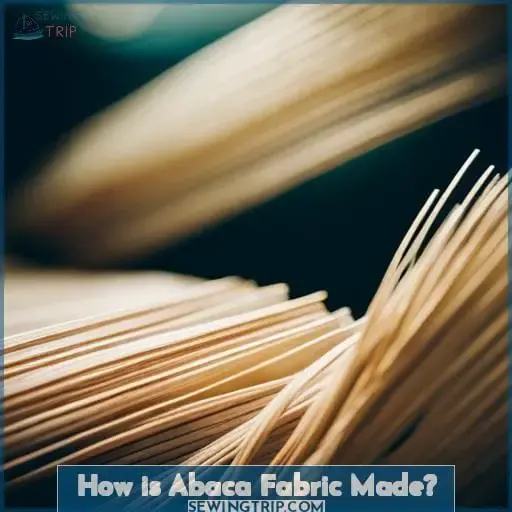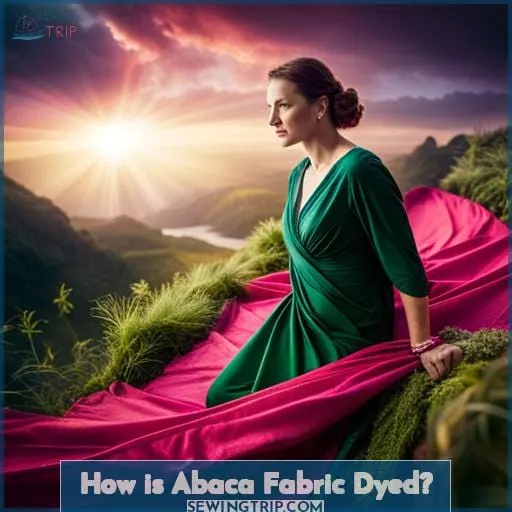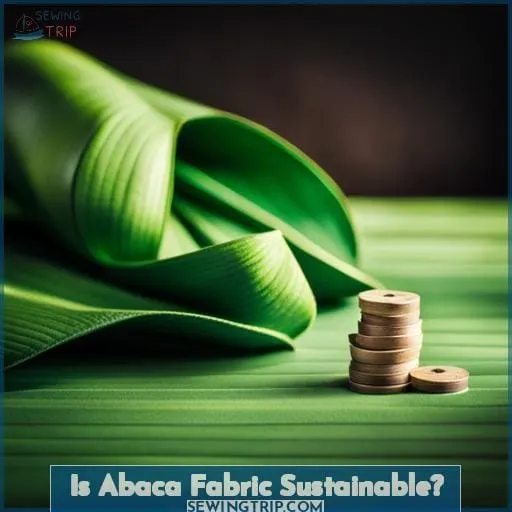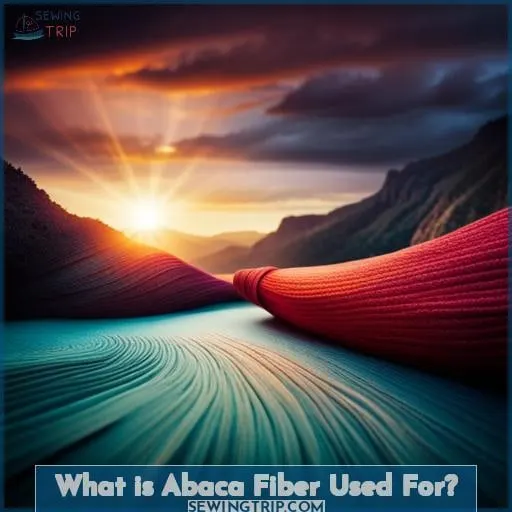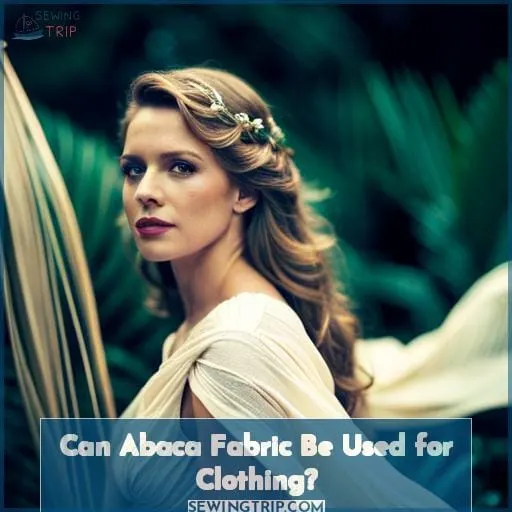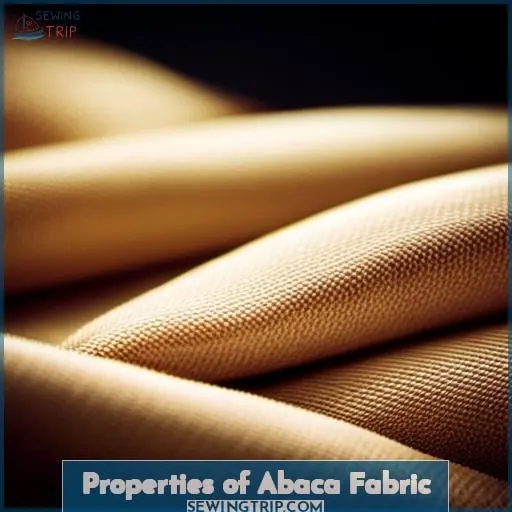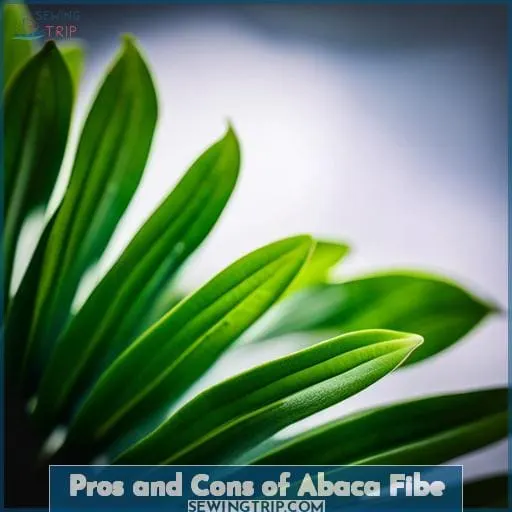This site is supported by our readers. We may earn a commission, at no cost to you, if you purchase through links.
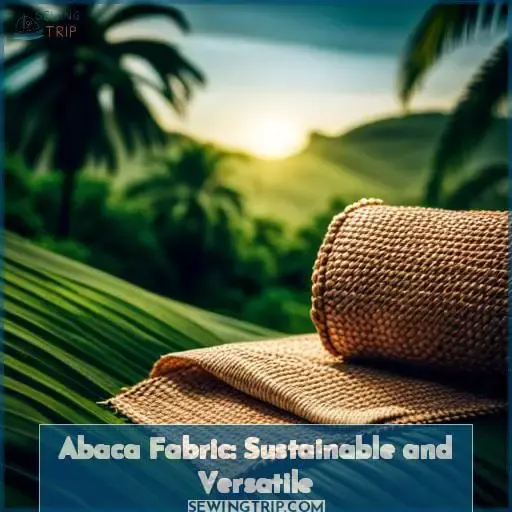 You’re standing on the cusp of discovering abaca fabric, an eco-friendly natural textile woven from the fibers of abaca plants’ leaves.
You’re standing on the cusp of discovering abaca fabric, an eco-friendly natural textile woven from the fibers of abaca plants’ leaves.
Biodegradable and versatile, abaca offers technical performance qualities comparable to glass fibers, making it suitable for applications from automotive components to shipping sacks. Yet beyond specifications, this fiber taps into dreams of environmental harmony and community self-reliance.
Join us in exploring abaca’s origins, sustainability benefits, production processes, and creative future frontiers.
Table Of Contents
Key Takeaways
- Abaca fabric is a durable, textured cloth made from fibers of abaca plants.
- It is native to the Philippines and is lightweight and relatively affordable.
- Abaca fabric is sustainable, biodegradable, and recyclable, making it an environmentally friendly option.
- It can be used for various purposes, including clothing, household items, and handicrafts.
What is Abaca Fabric?
Abaca fabric is your durable, textured cloth made from the fibers of abaca plants, a type of banana native to the Philippines. These fibers are known for their strength and versatility in textile production.
Abaca fabric has gained popularity not only for its eco-friendly nature but also for its unique texture and appearance.
When it comes to weight, abaca fabric is relatively lightweight compared to other fabrics like cotton or linen. This makes it suitable for various applications such as clothing, home furnishings, and even industrial use.
In terms of cost, abaca fabric can vary depending on factors such as quality and sourcing. Generally speaking though, due to its sustainable production process and availability in abundance within the Philippines where it’s predominantly grown; abaca fabric tends to be relatively affordable compared with other natural fiber textiles.
To care for abaca fabric properly, it’s important to follow specific instructions provided by manufacturers or consult professionals in the industry. What’s commonly recommended is handwashing with gentle detergent and air-drying to diminish any risk of damage from shrinking or fading.
Avoiding exposure to direct sunlight will also help maintain the vibrant colors of abaca fabric over time.
Overall, abaca fabric offers an intriguing combination of durability, texture, and sustainability, making it a truly versatile option for various applications throughout the lifestyle industry.
How is Abaca Fabric Made?
To create abaca fabric, the process begins with sourcing and processing raw materials.
Weavers scrape off strips of abaca stalks and separate the fibers before combing them to remove any remaining pulp.
The fine fibers are then separated from the coarse ones and left to dry indoors before being washed in a manner similar to handwashing clothes.
Sourcing and Processing Raw Materials
To create abaca fabric, you start by sourcing and processing the raw materials.
- Abaca plants can reach a height of 22 feet, with their leaves providing the fiber for the fabric.
- Weavers scrape off strips from the stalks before separating and combing the fibers to remove pulp.
- The fine fibers are separated from coarse ones and left to dry indoors.
- After air-drying, weavers rub them like hand-washing clothes.
Weaving Abaca Into Fabric
You weave the thoroughly combed abaca fibers into fabric using traditional wooden looms after air drying the fibers and rubbing them to remove any remaining pulp. Skilled artisans use manual looms and hand techniques to produce the woven abaca fabric.
This natural, biodegradable textile utilizes sustainable abaca fiber and traditional weaving methods to create a durable final product.
| Type of Loom | Advantages |
|---|---|
| Traditional wooden | More control over tension |
| Modern mechanical | Higher efficiency |
How is Abaca Fabric Dyed?
Now that you understand how Abaca fabric is made, let’s delve into the fascinating process of dyeing this natural fabric.
The indigenous people of the Philippines have a rich tradition of using natural dyes to color their Abaca fabric.
- Natural Dye: Indigenous communities rely on natural dyes sourced from plants to achieve vibrant colors.
- Red and Black: Traditionally, two main colors used for dying Abaca fabric are red and black.
- K’nalum Leaves: To obtain black dye, the intricate process involves extracting pigment from k’nalum leaves through rigorous methods.
- Other Colors: While red and black are most common, it’s possible to dye Abaca fibers in various other shades using natural sources found in their environment.
By utilizing these sustainable practices rooted in cultural heritage, the indigenous people create beautifully colored abaca fabrics while preserving traditional knowledge and contributing towards a more eco-friendly textile industry.
Is Abaca Fabric Sustainable?
Abaca fabric is a sustainable textile option due to its environmental benefits.
The abaca plant, from which the fabric is derived, doesn’t require fertilizers or pesticides to grow and it doesn’t release microfibers that pollute waterways and oceans.
Additionally, abaca fabric is biodegradable and recyclable, making it an eco-friendly choice for fashion textiles and other products.
Environmental Benefits of Abaca Fabric
With its numerous environmental benefits, abaca fabric proves to be a sustainable choice for conscious consumers.
Abaca fabric is biodegradable and compostable, making it an eco-friendly option. Unlike other crops used for textile production, the abaca plant requires no fertilizers or pesticides to grow.
Additionally, products made from abaca don’t release microfibers into waterways and oceans when washed.
Furthermore, burning abaca doesn’t generate toxic gases that harm the environment.
Biodegradability and Recyclability of Abaca Fabric
Continuing the discussion on the environmental benefits of abaca fabric, let’s explore its biodegradability and recyclability.
Abaca fabric is highly sustainable as it’s both compostable and biodegradable, making it environmentally friendly.
Additionally, abaca fabric exhibits durability and strength due to its high tensile strength.
Moreover, this versatile material can be easily recycled without causing harm to the environment, making it a truly sustainable choice for various applications.
What is Abaca Fiber Used For?
Are you wondering about the various uses of abaca fiber? This versatile natural fiber has many applications.
Commonly used for rope, abaca’s strength and resistance to salt water make it an ideal cordage material. Weavers also use it for packaging, bags, mats, and other household items like carpets and curtains.
Its softness lends well to clothing, with abaca fabric made into shirts, pants, and dresses.
Abaca’s natural texture and colors have decorative applications too – it brings a tropical, earthy look to handicrafts, wall hangings, and furniture coverings. Whether for utility, fashion, or décor, abaca fiber offers a sustainable, durable choice.
With its durability, breathability, and artisanal look, abaca suits various niches from industrial materials to boutique fashion. This eco-friendly fiber holds up to heavy use in rope and sack production, yet also drapes smoothly into dresses and knitwear.
Abaca’s versatility stems from the inherent qualities of the plant itself – itsleaves yield fibers usable for all kinds of woven, braided, and twisted goods.
Can Abaca Fabric Be Used for Clothing?
Abaca fabric can be used for clothing as it offers a sustainable and versatile option for fashion.
With its durable and breathable properties, abaca fabric is strong enough to withstand the demands of daily wear while providing comfort to the wearer.
Its natural fibers make it eco-friendly and biodegradable, contributing to a more sustainable fashion industry.
Additionally, abaca fabric is resistant to salt water and insects, making it suitable for beachwear or outdoor clothing where these factors may come into play.
Furthermore, abaca fabric is recyclable, allowing for its continued use in future textile production processes.
Overall, incorporating abaca fabric into clothing not only promotes sustainability but also provides a stylish choice that meets the needs of individuals seeking both functionality and environmental consciousness in their wardrobe choices.
Properties of Abaca Fabric
As you consider using abaca fabric for clothing, it’s important to understand the unique properties that make this fiber so versatile.
Abaca is breathable and durable, with a high tensile strength that makes it long-lasting.
This eco-friendly fabric also absorbs moisture well thanks to its natural fiber composition.
Whether woven thinly for lightweight shirts or more densely for outerwear, abaca offers the strength to hold structure while remaining easy on the planet. Its biodegradability makes it a sustainable choice as a fabric fiber from an environmental perspective as well.
With attributes like strength, comfort and sustainability, it’s no wonder abaca is growing in popularity for modern textile and fashion applications.
Pros and Cons of Abaca Fibe
When considering abaca fiber for your projects, it’s important to weigh the pros and cons.
Abaca fabric offers several advantages that make it a desirable choice.
Firstly, abaca fiber is highly durable and has excellent tensile strength, ensuring longevity in various applications.
Additionally, its versatility allows for a wide range of uses in clothing, accessories, packaging materials, and industrial products.
Moreover,
abaca fabric is biodegradable and eco-friendly since it comes from organic plant fibers that decompose naturally without causing harm to the environment.
Furthermore,
abaca fabric provides breathability due to its natural composition which makes it comfortable on the skin.
However,
there are some drawbacks worth noting as well.
Abaca garments are prone to damage by insects,
molds,and fungi due
to their organic properties.
Considering these factors will help you make an informed decision when utilizing this sustainable textile resource.
Frequently Asked Questions (FAQs)
How long does it take for an abaca plant to mature before its leaves can be harvested for fabric production?
Abaca plants must reach a minimum age of four years before their leaves can be harvested for fabric production. This ensures that the fibers are strong and durable, meeting the high standards required for abaca fabric.
Are there any specific environmental conditions required for growing abaca plants?
To successfully cultivate abaca plants, you must provide them with the perfect environment:
- A tropical paradise
- Complete with abundant rain
- Warm temperatures
- Rich soil.
Without these conditions, your dreams of owning an abaca fabric empire will remain just that – dreams.
What are the traditional colors used for dyeing abaca fabric?
To dye abaca fabric, traditional colors such as red and black are used.
These natural dyes are extracted from plants found in the environment, with the process for obtaining black dye being more rigorous than that of red dye.
Can abaca fabric be easily blended with other materials?
Yes, abaca fabric can be easily blended with other materials to enhance its properties and create innovative textiles.
This blending process allows for the incorporation of different fibers, resulting in unique combinations that offer enhanced strength, durability, and versatility.
What are the potential drawbacks of using abaca fabric for clothing?
Abaca fabric, while durable and versatile, has potential drawbacks for clothing.
It’s prone to wrinkling, changes color in sunlight, lacks comfort and can feel rough.
Additionally, it has low resistance to insects, moths, molds, and fungi.
Conclusion
Like strands on a loom interlacing towards new beginnings, abaca offers environmental harmony through community ties.
As versatility takes root, may our dreams bloom sustainable futures from this biodegradable fiber, branching technical capabilities as strong as steel yet gentle as the leaves they sprung from.
What abaca fabric lacks in cons, it makes up for in far-reaching potential still being woven.

